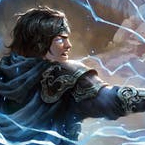The furnaces of rebellion are lit in Volcor, threatening to topple the hierarchy and throw the land into chaos- but amidst the civil war is a lone wanderer looking for answers. Iyslander the Ice Wizard is caught in the crossfire, and she sticks out like a sore thumb in the volcanic wasteland...
The Uprising has arrived! After a long stint in Aria across both Tales of Aria and Everfest, we finally get to see another of Rathe’s regions represented in a standalone booster set. But it couldn’t have gone without just a hint of that elemental magic.
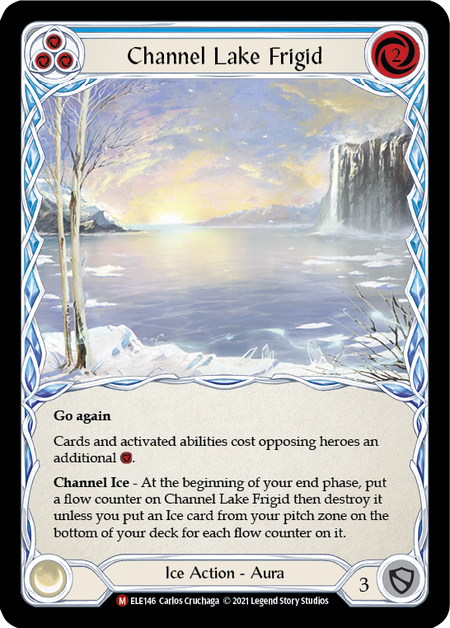

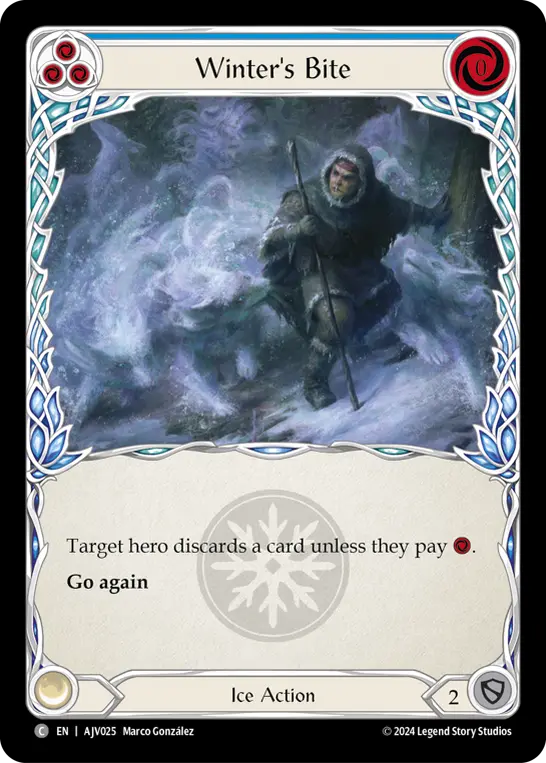
The ice wizard Iyslander had already shown up in Everfest, and was a strong deck even without specific support cards. Her hero ability allows for blue cards to be played at instant speed from arsenal; and whenever she plays an Ice card on her opponent’s turn, she gives them a Frostbite.
Being able to play instant-speed disruption cards like Channel Lake Frigid and Winter’s Bite made her a premium anti-aggro hero even before she got any cards of her own. Now we see her full form in Uprising.
The Way of the Bleak Expanse
As a fully-realized adult hero, Iyslander, Stormbind got a whole suite of new tools, including Elemental Wizard and Ice Wizard cards, expanded fusion effects, new Ice toys, and fresh weaponry and equipment. Her majestic cards facilitate crippling control plays and potent win conditions.
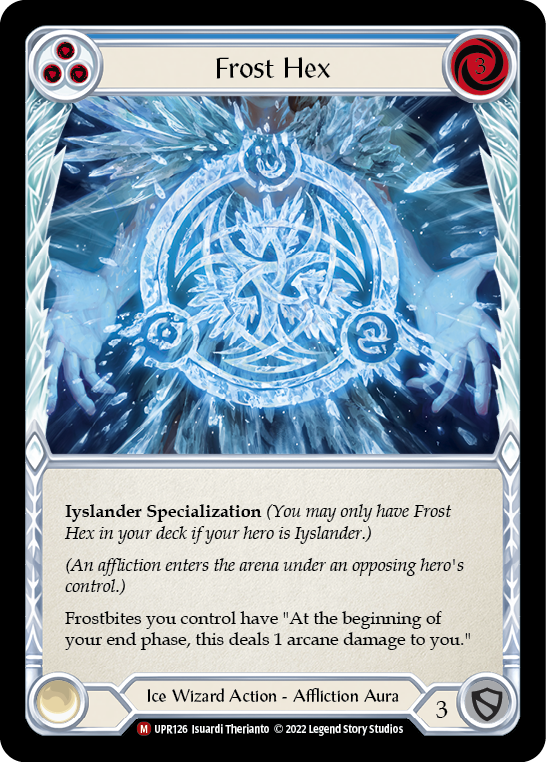
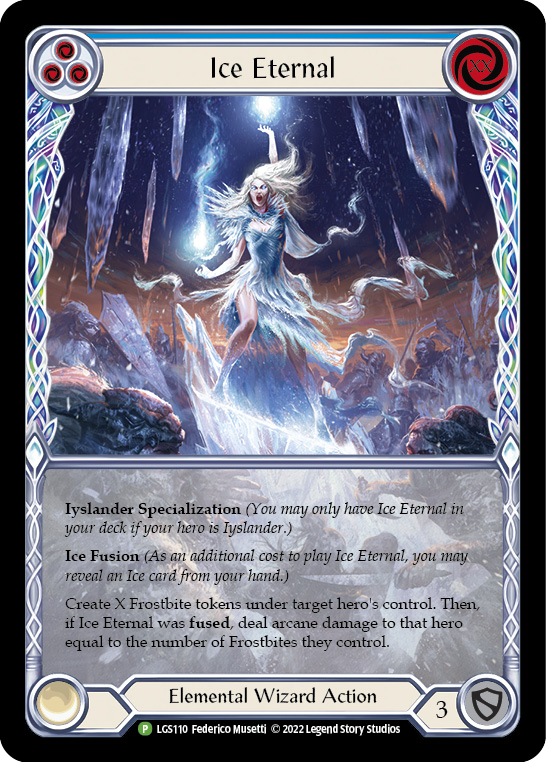
Most exciting among these (and the one that informs her playstyle the most) is Frost Hex, a specialization that turns your excess of Frostbites into ping damage that can either help chip down your opponent or win the game outright with multiple hexes and a big Frostbite engine like Ice Eternal.
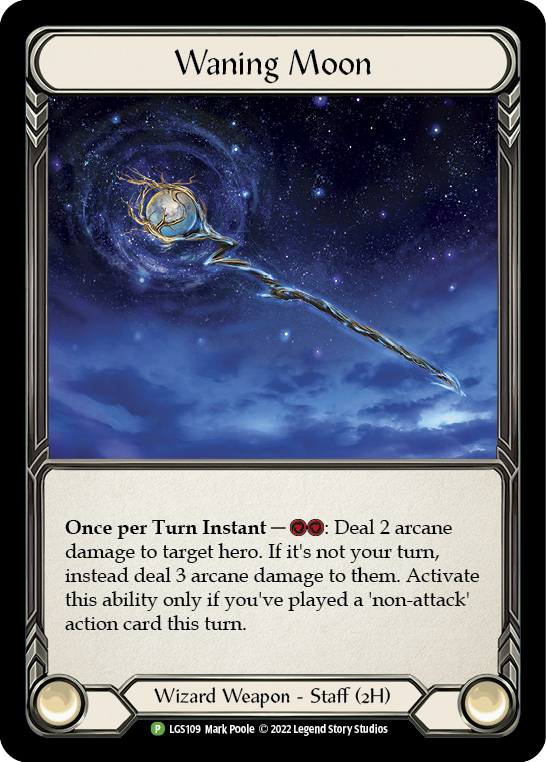
Iyslander's new weapon, Waning Moon, does chip damage with unrivaled efficiency. Having the consistent option to play a blue non-attack action from arsenal on your opponent’s turn makes Waning Moon easy to enable. No opponent wants to commit 3 resources to block this arcane damage on their turn, so the damage tends to get through. Pair this with Iyslander’s ability to completely shut down her opponent’s turn with Ice cards and Frostbites, and you’ll find yourself trading damage surprisingly well even into the most aggressive decks. In fact, this card is good enough to build around. How about we do that?
Absolute Zero
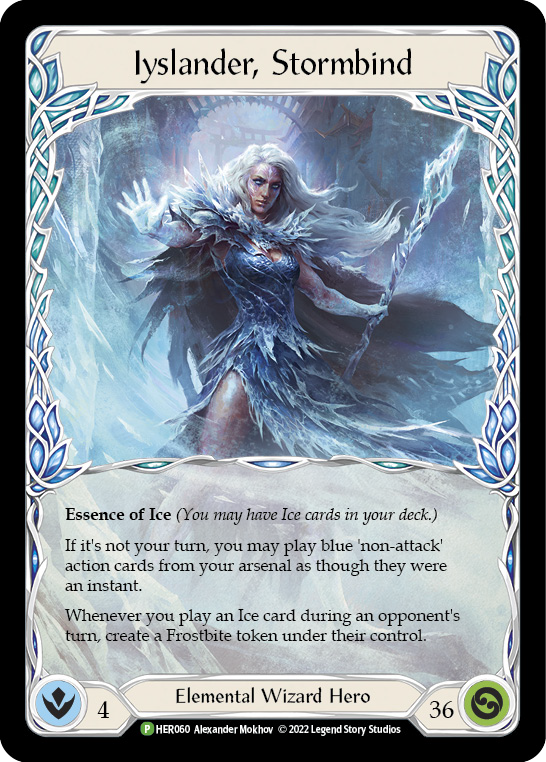
Weapons
- Waning Moon (1)
Equipment
- Coronet Peak (1)
- Alluvion Constellas (1)
- Fyendal's Spring Tunic (1)
- Ironhide Gauntlet (1)
- Storm Striders (1)
- Metacarpus Node (1)
Loadout
- Amulet of Ice (Blue) (3)
- Arctic Incarceration (Red) (3)
- Channel the Bleak Expanse (Blue) (2)
- Frosting (Blue) (3)
- Channel Lake Frigid (Blue) (3)
- Ice Eternal (Blue) (3)
- Freezing Point (Red) (3)
- Cold Snap (Red) (3)
- Cold Snap (Blue) (3)
- Arctic Incarceration (Blue) (3)
- Aether Hail (Red) (3)
- Aether Hail (Blue) (3)
- Aether Icevein (Red) (3)
- Aether Icevein (Blue) (3)
- Exposed to the Elements (Blue) (2)
- Hypothermia (Blue) (2)
- Fate Foreseen (Red) (3)
- Ice Bolt (Blue) (3)
- Fyendal's Fighting Spirit (Yellow) (3)
- Nourishing Emptiness (Red) (1)
- Insidious Chill (Blue) (3)
- Sink Below (Red) (3)
- Frost Hex (Blue) (3)
- Sigil of Permafrost (Red) (3)
- Winter's Bite (Blue) (3)
- Blizzard (Blue) (3)
Pros:
- Unparalleled defence and disruption
- Top-tier chip damage
- Strong combo game
Cons:
- Struggles against other set-up decks
- Low damage output
- Hard to regain tempo when lost
Pure. Control. Nothing else. Every piece of Ice disruption we could possibly fit in, the defense and survivability to outlast almost any opponent, and the slow and inevitable win condition of Frost Hex and Waning Moon.
The plan is to slow our opponent down to a total halt and protect our life total while setting up Frost Hex and whittling away with Waning Moon. Cards like Channel Lake Frigid, while in every Iyslander deck, absolutely shine here, along with the new cards Sigil of Permafrost and Arctic Incarceration.
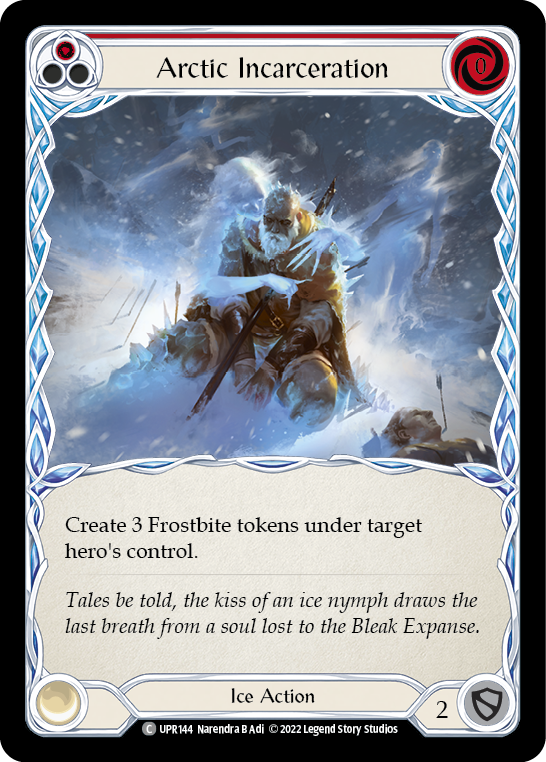
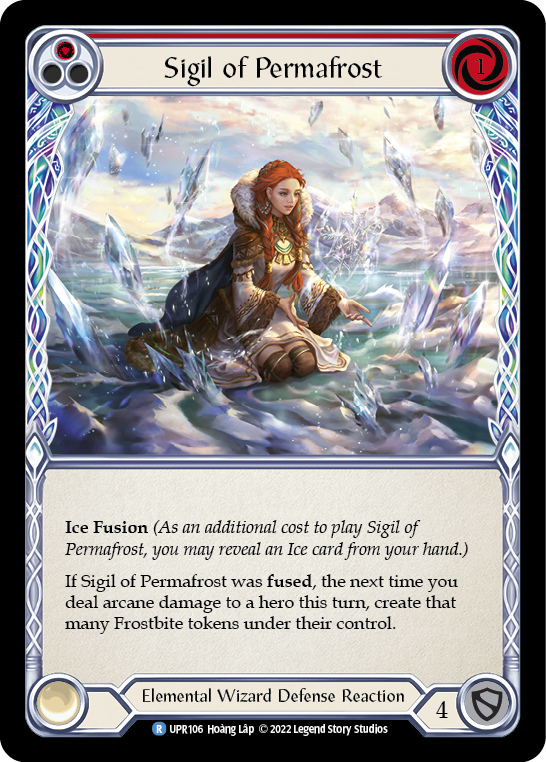
Sigil of Permafrost is unassuming to start, but it pairs very well with Waning Moon and a zero-cost non-attack action from arsenal. Pitching for 3 to play a fused Sigil of Permafrost, then using our non-attack action from arsenal and pinging with Waning Moon for 3 damage and 3 Frostbites, is a sure-fire way of grinding our opponent to a halt. In addition, we have red Arctic Incarceration as a premium 1-card play, and a suite of frosty tech cards like Blizzard, Hypothermia, Channel the Bleak Expanse, and Exposed to the Elements to attack specific matchups.
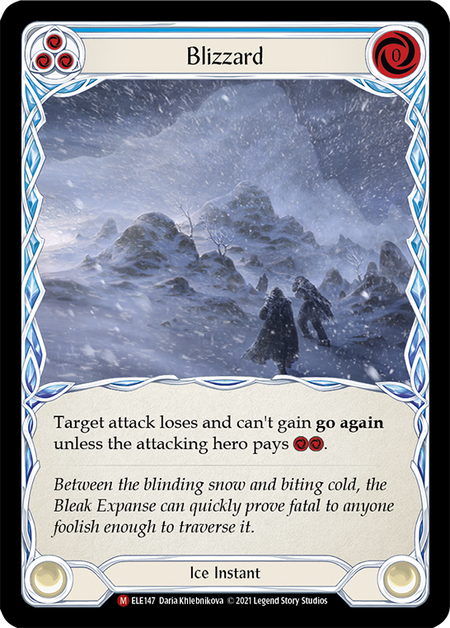
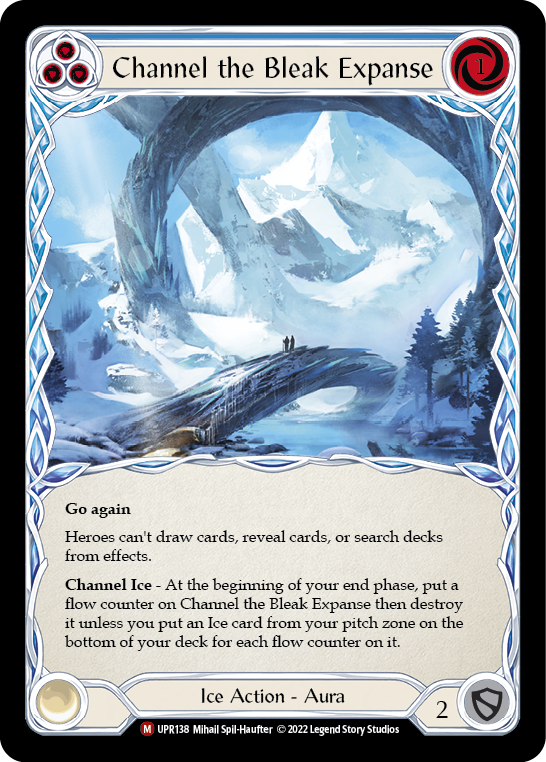

Despite how strong this deck’s game is against aggressive decks that try to push you out of the game as soon as possible, it has an impressive backup plan for decks that take you to the long game, such as an Oldhim or the mirror. This is where the cards that force our opponents to discard come in- namely, Amulet of Ice and Insidious Chill.
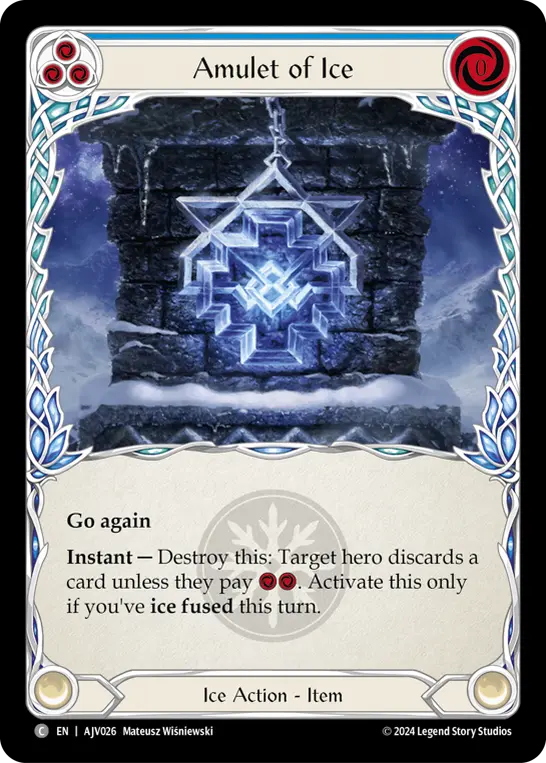
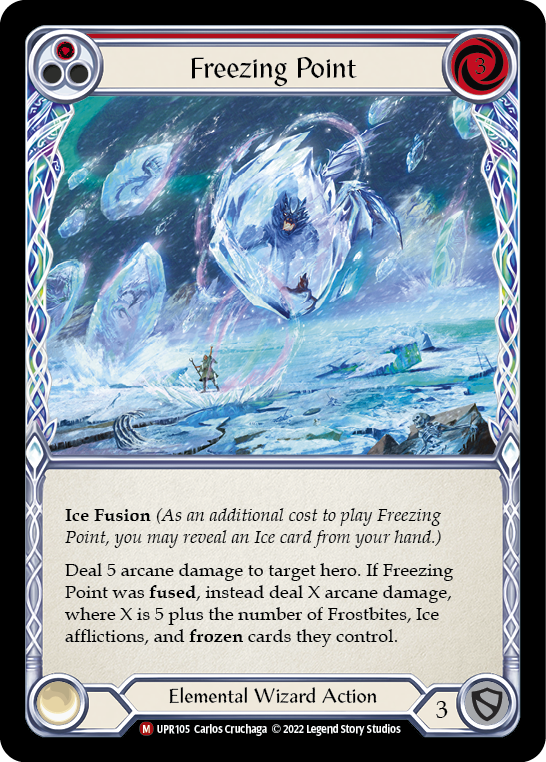
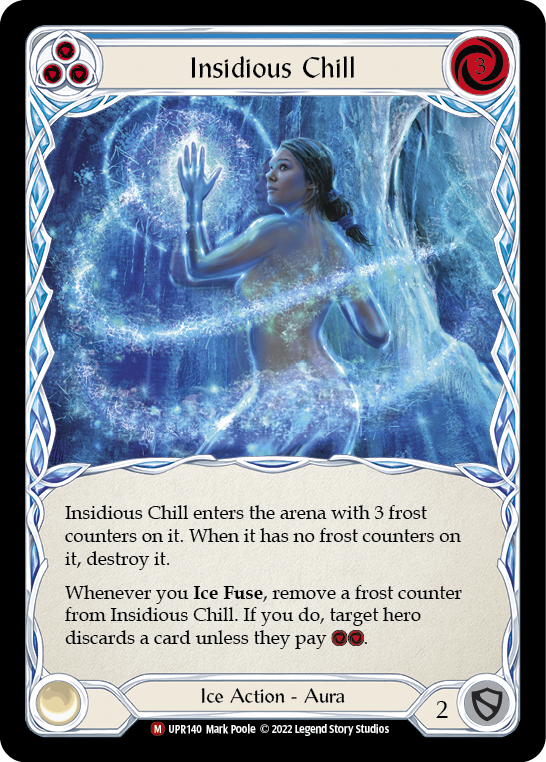
This deck does not fuse very often, so when an Insidious Chill comes down, we can always save it for when it matters most. Our goal is to spend the game setting up Chills, Amulets, and Frost Hexes, then fuse a Sigil of Permafrost, using our setup to force our opponent to discard their entire hand. Then we use Storm Striders to play Freezing Point- or just a large Ice Eternal from arsenal- to create a whole pile of Frostbites that all ping for 3 at the end of the turn, dealing up to 30 damage.
This deck is great for those pure control players that want nothing more than to outlive and outlast, freezing your opponents out of the game while you slowly gain incremental advantage. The wide sideboard allows for a tailored deck against almost every matchup, and the extensive Ice engine is going to constantly stop your opponents from playing at their strongest.
Lockout Knockout

Weapons
- Waning Moon (1)
Equipment
- Coronet Peak (1)
- Alluvion Constellas (1)
- Fyendal's Spring Tunic (1)
- Ironhide Gauntlet (1)
- Storm Striders (1)
- Metacarpus Node (1)
Loadout
- Amulet of Ice (Blue) (3)
- Channel the Bleak Expanse (Blue) (2)
- Frosting (Blue) (3)
- Channel Lake Frigid (Blue) (3)
- Ice Eternal (Blue) (3)
- Freezing Point (Red) (3)
- Isenhowl Weathervane (Red) (3)
- Cold Snap (Blue) (3)
- Arctic Incarceration (Blue) (3)
- Aether Hail (Red) (3)
- Aether Hail (Blue) (3)
- Icebind (Blue) (3)
- Aether Icevein (Red) (3)
- Icebind (Red) (3)
- Aether Icevein (Yellow) (3)
- Aether Icevein (Blue) (3)
- Encase (Red) (3)
- Hypothermia (Blue) (2)
- Ice Bolt (Blue) (3)
- Fyendal's Fighting Spirit (Yellow) (3)
- Insidious Chill (Blue) (3)
- Frost Hex (Blue) (3)
- Sigil of Permafrost (Red) (3)
- Winter's Bite (Blue) (3)
- Blizzard (Blue) (3)
Pros:
- Total lockdown of your opponent
- Higher damage output
- Wins in a landslide when ahead
Cons:
- Heavily relies on good draws
- Needs tempo to survive
- Does nothing when fuse payoff is spent
If the last deck was about barely letting your opponent play, this one is about not letting them play at all. They could go grab lunch in the middle of the game and the result would be the same! But it comes at the cost of consistency. This is an Ice fusion lockout deck inspired by Ice Lexi, making use of all the new Ice cards and the new Ice fusion synergies- most notably, Isenhowl Weathervane, Aether Icevein, and Insidious Chill. The goal is tempo, using your fuse cards to force so many cards out of your opponent’s hand that they have nothing left to play even if they wanted to.
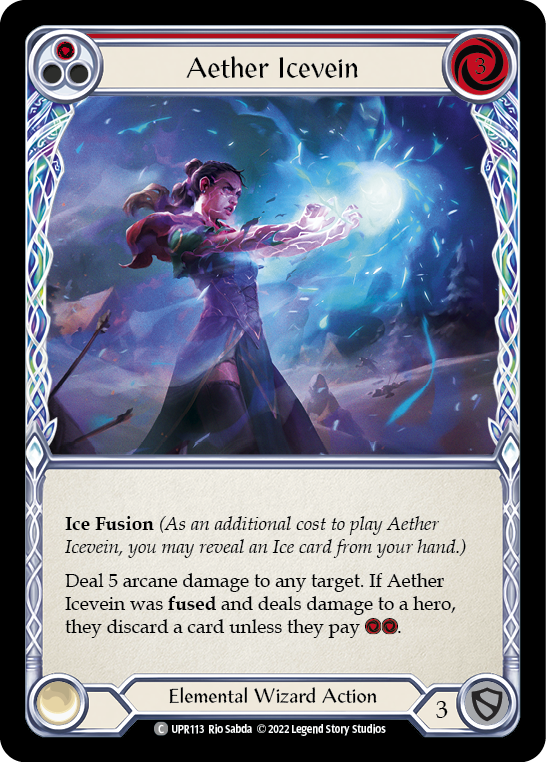
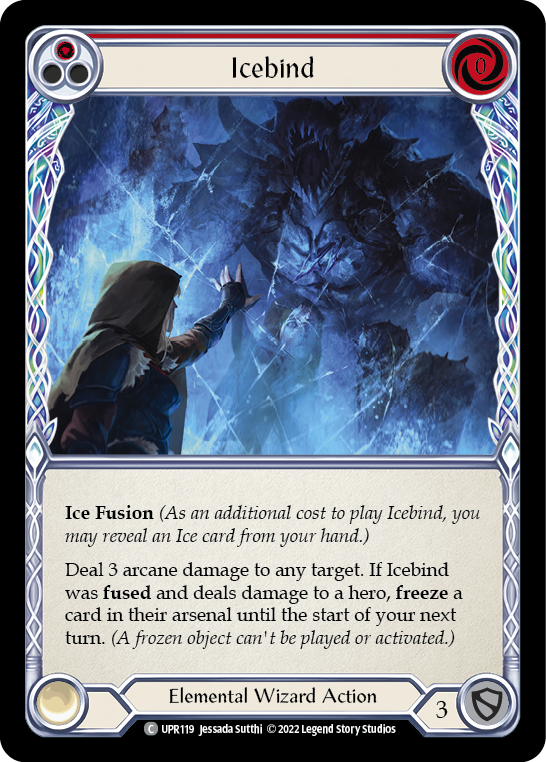
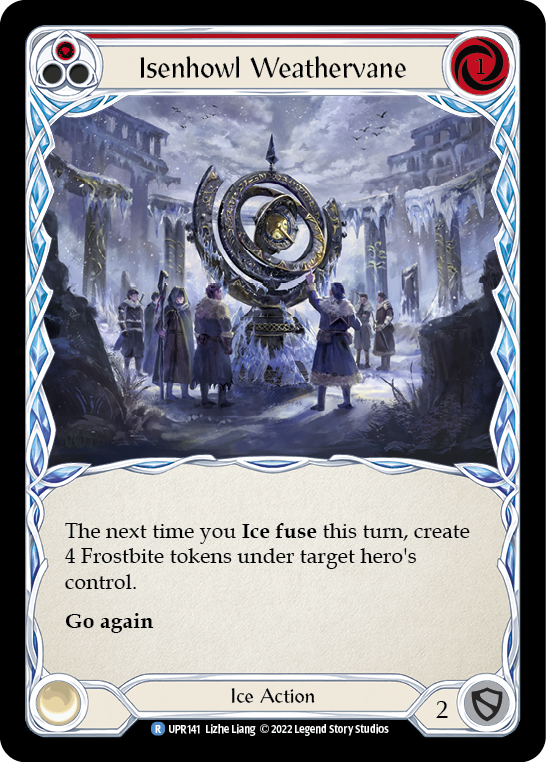
The card that really drew me to this idea was Isenhowl Weathervane- particularly how it fit in with the pitch curve of the deck. It allows us to use all our resources extremely efficiently with the inclusion of some zero-cost fuse cards like Encase and red Icebind. The pattern of play you're looking for is pitching blue to use Isenhowl Weathervane, then playing a fused zero-cost card to generate the Frostbites on top of its own effect, and using the two floating for Waning Moon- putting the Ice card you fused with into arsenal. These kinds of plays are frequently strong enough to force your opponent to skip their turn, and open up a unique luxury for Iyslander: the freedom to arsenal a red.
Alongside Isenhowl Weathervane, the real key cards to this kind of playstyle are Insidious Chill, Amulet of Ice and Aether Icevein. Anything that forces your opponent to discard a card is at a premium. Ideally the real legwork gets done by Icevein- hence the 9 copies- and Insidious Chill, with Amulet of Ice as a backup in case you need to steal more cards to ensure your opponent skips their turn.
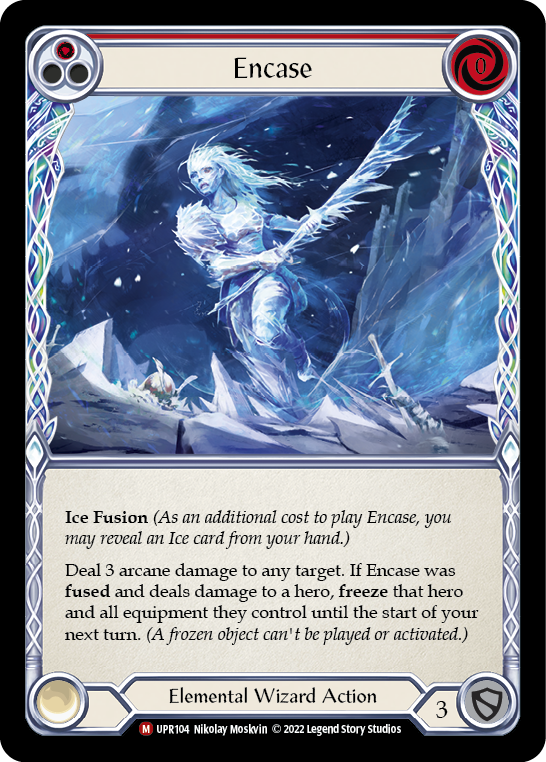

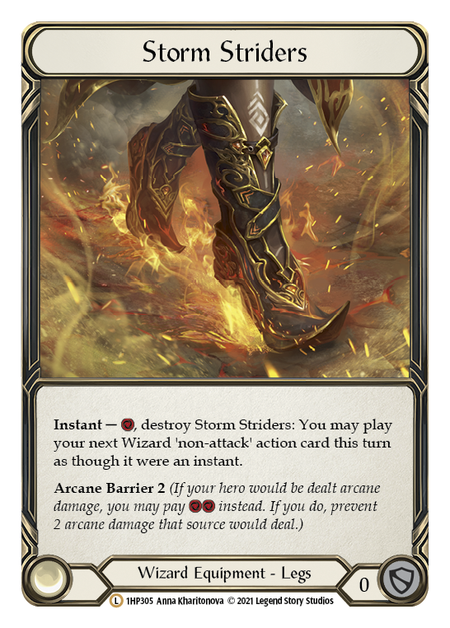
This deck uses Storm Striders aggressively to steal tempo at an important moment. My favorite way to do this is with Encase and Freezing Point, preferably with an Insidious Chill. Fusing an Encase on your turn- with Metacarpus Nodes if needed to freeze your opponent’s board- then using Striders to play a Freezing Point- usually for 11- is a massive swing. Striders can also be used on your opponent’s turn with an Aether Icevein and some other forced discard effect to make your opponent discard their hand when they’ve just started to play.
This deck is insanely fun when it works, but of the decks presented here, it is certainly the most fragile. It relies on drawing a good distribution of Elemental and Ice cards, and on getting an Amulet or Insidious Chill down early. But when you do, and when the draws work out, this deck is an unstoppable menace. Great for people who enjoy seeing their friends suffer.
Muscle Mage

Weapons
- Kraken's Aethervein (1)
Equipment
- Coronet Peak (1)
- Goliath Gauntlet (1)
- Alluvion Constellas (1)
- Fyendal's Spring Tunic (1)
- Storm Striders (1)
Loadout
- Amulet of Ice (Blue) (3)
- Enlightened Strike (Red) (3)
- Channel the Bleak Expanse (Blue) (2)
- Frosting (Blue) (3)
- Channel Lake Frigid (Blue) (3)
- Ice Eternal (Blue) (3)
- Freezing Point (Red) (3)
- Aether Hail (Blue) (3)
- Aether Icevein (Red) (3)
- Icebind (Red) (3)
- Exposed to the Elements (Blue) (1)
- Encase (Red) (3)
- Hypothermia (Blue) (2)
- Polar Blast (Blue) (3)
- Ice Bolt (Blue) (3)
- Fyendal's Fighting Spirit (Yellow) (3)
- Command and Conquer (Red) (3)
- Emeritus Scolding (Blue) (3)
- Insidious Chill (Blue) (3)
- Frost Fang (Red) (3)
- Frost Hex (Blue) (3)
- Ice Bolt (Red) (3)
- Sigil of Permafrost (Red) (3)
- Scour (Blue) (3)
- Winter's Bite (Blue) (3)
- Blizzard (Blue) (3)
Pros:
- Forces lose-lose decisions on opponents
- Faster deck cycling
- Stronger into Illusionists
Cons:
- Opponent’s get to decide their blocks
- Weaker chip damage
- Less consistent ice disruption
The muscle mage was my favorite way to play Iyslander prior to Uprising. Using threatening attack actions to force blocks and punishing those blocks by throwing a ping of Kraken’s Aethervein, forcing your opponents to decide whether to commit a third card to block or take the damage and let you cycle to your important pieces faster. Command and Conquer, Enlightened Strike, and Frost Fang are key here, with the new Erase Face as a backup.
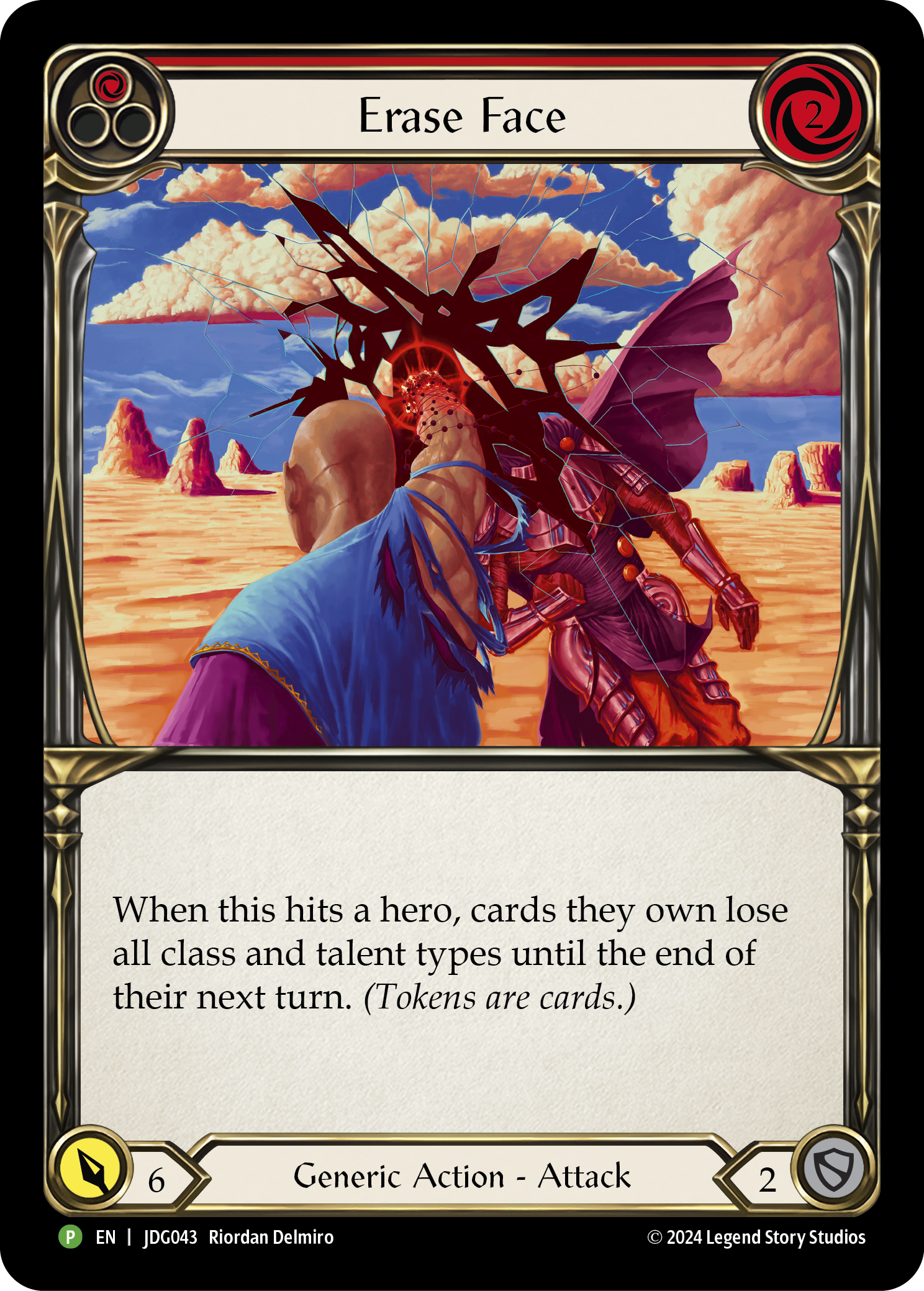
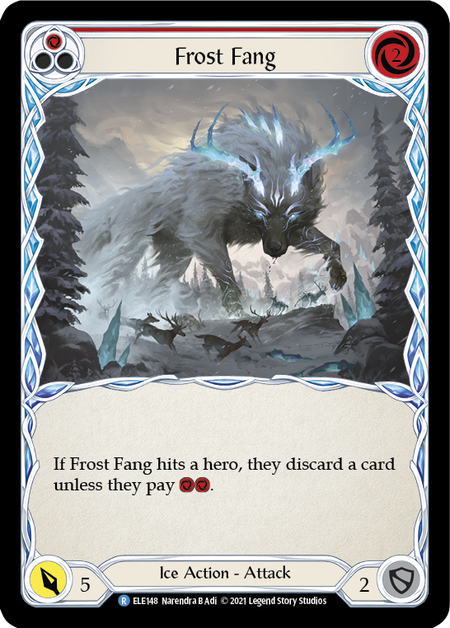
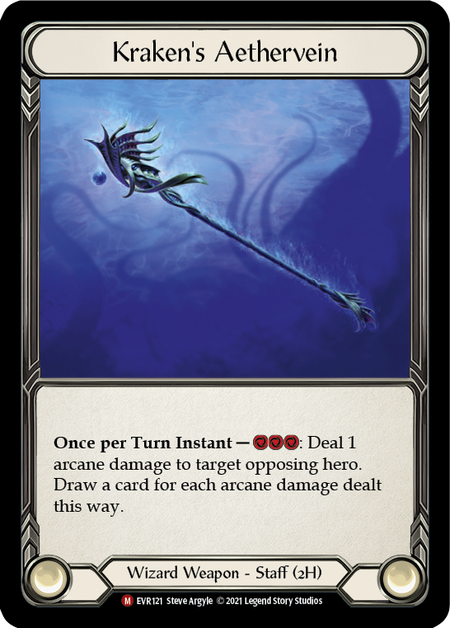
Another benefit of running attack actions is that it gives your opponent an excuse to commit cards. One of the downfalls of Wizards in general is that the number of cards you can strip from your opponent is limited by how Arcane Barrier works, meaning most of the time a card can only trade for one card from your opponent. However, playing the game normally– i.e. with attacks– gives your opponent a chance to commit more cards to the block. In addition, the damage that they do choose to take is far more valuable to a Wizard than any other opponent, as every point they take is a point closer to a spontaneous instant-speed lethal.
Without Waning Moon, the curve of this deck ends up looking a little different, leaving behind Sigil of Permafrost and Isenhowl Weathervane in favour of zero-costs like Icebind and Encase that force the same lose-lose decisions as your attack actions when paired with Kraken’s Aethervein. These cards are your backups for when keeping 3 cards for the attack action and Aethervein plan doesn’t line up, allowing to strip a card and arsenal an impactful ice card to prepare for the next turn.
The backup to the backup, then, becomes Coronet Peak, which shines the most when paired with Kraken's Aethervein, especially on a 2-blue hand with no arsenal. If your opponent does not block Aethervein, then you draw a blue and Coronet Peak steals the card guaranteed. If they do, then you arsenal your last card. The impact of these plays seems low, but few decks can claim to be able to always strip a card with nothing but blues.
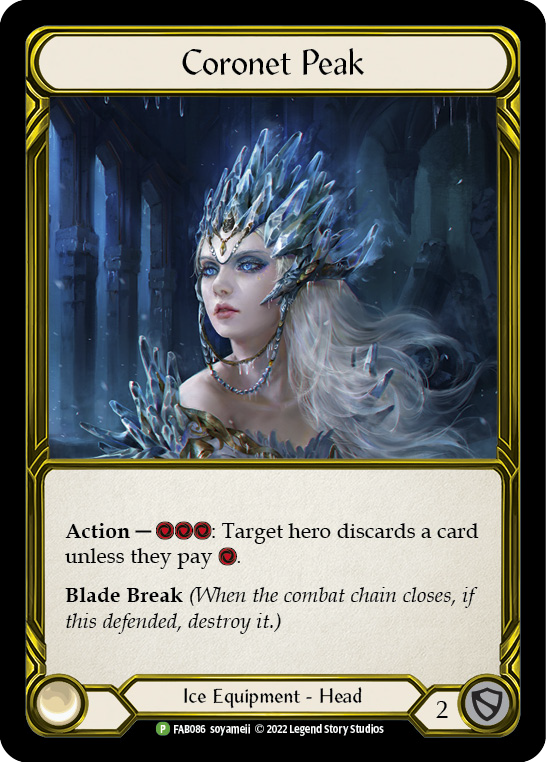
This hybrid style of play has always been a fan favorite way to play Wizard, and in Iyslander the attack engine can easily pair with a more robust control core or a tempo gameplan. Muscle Mage shines in slower games, where the attacks can smooth out the mid-game while you set up for your combo finish; but it's also a great way to punish unsuspecting aggro players with the amount of uncomfortable decision points it can force.
Cold Comfort
One way or another, Iyslander is fun to play, and frighteningly powerful in the right hands. Each of her popular playstyles is a viable way to build the deck, and any blending of them can work as well. The control core pairs nicely with the attack action-based midgame, the fuse lockouts could do with the consistency of a Command and Conquer, and a hard control deck that can sideboard into a tempo fuse deck on a whim could be a great way to diversify the lines of play available to you. Ultimately, each of these decks is more of a toolbox than its own product, and I welcome anybody to pick and choose the ideas they want to apply to their own deckbuilding.
It’s a little too early to determine whether or not Iyslander will be a top meta contender- especially when she is so well countered by Prism, one of the most popular CC decks ever- but she has a very versatile toolkit and one of the most unique play patterns of any hero in the game. Instant speed disruption is a powerful toy, and hopefully that is enough to push her up the rankings and make her a true competitively viable Wizard. I, for one, welcome our new frostbitten overlords.


